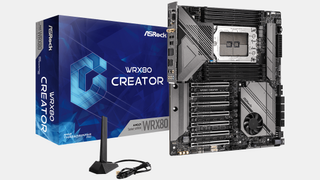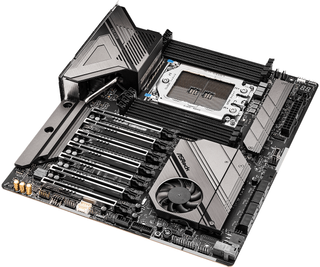ASRock Ditches Intel Ethernet, Cuts Price of Threadripper Pro Motherboard by $356
A small swap of a 10GbE controller leads to a major price reduction.

ASRock has quietly released revision 2.0 of its WRX80 Creator motherboard for AMD's Ryzen Threadripper Pro processor that costs more than $350 less than the revision 1.0 of the same mainboard, which was released this August. The only difference between the two boards? The new model uses Marvell's Aquantia 10GbE controller instead of an Intel 10GbE controller.
Other than 10GbE controllers, ASRock's WRX80 Creator motherboards are absolutely identical. Both use a 14-layer printed circuit board (something that is hardly ever used, even for enthusiast-grade motherboards designed for overclockers). Both boards come with voltage regulating modules (VRMs) featuring Infineon's premium DrMOS power stages, promising extended longevity and generally designed for reliability and durability. Features and capabilities of the platforms can be compared on ASRock's website, or using the brief table below.
Both motherboards are now available at Newegg. The new ASRock WRX80 Creator revision 2.0 costs $899, while the ASRock WRX80 Creator revision 1.0 is priced at $1256. The mention of the revision 2.0 at Newegg's website has been discovered by @momomo_us, as ASRock has not officially announced the new version of its product.

Both motherboards support AMD's Ryzen Threadripper Pro CPUs for high-end workstations, and therefore support up to 2TB of DDR4-3200 memory using eight channels and have 128 PCIe 4.0 lanes (up from 72 on non-Pro TR), spread across its seven PCIe 4.0 x16 (electrical), M.2-2280 as well as U.2 Gen4 x4 slots.
They also feature all the premium input/output capabilities imaginable, which includes two 10GbE ports (Intel-powered on revision 1.0 and Marvell Aquantia-powered on revision 2.0), Wi-Fi-6E, Thunderbolt 4, eight SATA connectors, 7.1-channel audio with a headset amplifier, a built-in KVM, and Aspeed's AST 2500 BMC for remote management.
In general, there seem to be no differences between the two ASRock's WRX80 Creator motherboards other than the 10GbE controllers. But many enterprise clients (who are more likely to purchase workstation-grade hardware) demand an Intel network controller, since their IT departments know how to manage them. Also, Intel's controller supports the Energy Efficient Ethernet 802.3az feature, something that may be important for business customers.
By contrast, ASRock's WRX80 revision 2.0 with a Marvell 10GbE controller provides similar performance for $350 less. This will definitely be an important factor to consider for boutique workstation makers as well as DIYers. Is Intel's 10GbE controller worth that much more?
Stay on the Cutting Edge
Join the experts who read Tom's Hardware for the inside track on enthusiast PC tech news — and have for over 25 years. We'll send breaking news and in-depth reviews of CPUs, GPUs, AI, maker hardware and more straight to your inbox.


Anton Shilov is a Freelance News Writer at Tom’s Hardware US. Over the past couple of decades, he has covered everything from CPUs and GPUs to supercomputers and from modern process technologies and latest fab tools to high-tech industry trends.
-
cyrusfox Pretty sure Intel isn't charging $350 for a 10GBe NIC chip(A 2 port add on card is only $150).Reply
Is this just Asrock cutting price to be competitive while changing out a mildly cheaper 10GBe to try to keep margins somewhat healthy? -
Eliad Buchnik True the controller itself costs 130$ at intel ark information:Reply
https://www.intel.com/content/www/us/en/products/sku/41282/intel-82599es-10-gigabit-ethernet-controller/ordering.htmlASRock can save few bucks. The price reduction probably comes from other places mostly. -
thestryker The regular retail price on the original version was also $900, the $1256 quoted in this article is from a third party seller. This is just ASRock making the margin higher by putting a worse controller on the board.Reply -
rluker5 Reply
Nice find.thestryker said:The regular retail price on the original version was also $900, the $1256 quoted in this article is from a third party seller. This is just ASRock making the margin higher by putting a worse controller on the board.
I searched and #2, Amazon was out so I went to #4: ASRock WRX80 CREATOR Motherboard For AMD Ryzen Threadripper PRO CPUs Now Available For $899 US (wccftech.com)
And the title was enough :P -
slash3 Replythestryker said:The regular retail price on the original version was also $900, the $1256 quoted in this article is from a third party seller. This is just ASRock making the margin higher by putting a worse controller on the board.
I seriously don't understand how things like this keep making it into news posts here on Tom's. It takes literally three seconds to see that the retail price hasn't changed, and that it's a 3rd party seller, as you say.
Someone needs to have a staff meeting; it's getting out of hand. -
thestryker Reply
Yeah it's still notable due to the NIC change, but the price change bit is a big miss.slash3 said:I seriously don't understand how things like this keep making it into news posts here on Tom's. It takes literally three seconds to see that the retail price hasn't changed, and that it's a 3rd party seller, as you say.
Someone needs to have a staff meeting; it's getting out of hand. -
Foeke We are grossly overestamating the impact of the BOM on the actual price.Reply
Come on guys, We just had a year where I could sell my 7 year old videocard for more than I bought it for. (I actually gave it away to do my tiny part in stopping this nonsense).
We are paying double the fuel price but the oil price is less than between 2010 and 2014.
Prices are based on fate and/or crooks. -
bit_user Reply
Having seen the other side of this, I can tell you that you're grossly underestimating what happens in the event of a parts shortage.Foeke said:We are grossly overestamating the impact of the BOM on the actual price.
My employer sells "appliances" based on PCs. We work with contract manufacturers and while I'm not dealing with them myself, I hear a bit about some of the problems. It seems some Ethernet chip (a PHY, I presume) has been the chief issue for us. What happens is that when a given part starts to have longer and longer lead times, the companies using it will up their orders to try and ensure they have enough inventory to fulfill their orders. Pretty soon, scalpers catch wind of the situation and buy up all the supply of it they can find. Now, what should be a $1 part is selling for $100s, if you can even find them. Just because they can.
I'm not an expert on oil, but there are complicated dynamics in this market. Shipping can be a bottleneck, as can refinery capacity and costs. The specific type of oil can also vary more than the "Texas light sweet crude" or whatever they quote as the indicator you hear on the news.Foeke said:We are paying double the fuel price but the oil price is less than between 2010 and 2014.
The free market for these big commodities tends to work very well when the situation is fairly stable. Then, the bottlenecks tend to get ironed out and we have lower & more uniform prices all the way out to the gas pump. However, when you throw a wrench into the works by having like 1/3rd of the oil consumers suddenly switching where they're trying to source oil from, it creates huge bottlenecks in shipping, distribution, refining, etc. because market dynamics don't incentivize keeping a lot of spare capacity in those areas.
When supply disruptions meet inelastic demand, get ready for some fireworks. And yes, there are definitely some bad actors that make the situation even worse.Foeke said:Prices are based on fate and/or crooks. -
Foeke Reply
I'm not underestimating the effect of supply shortages. You call them scalpers, I call them crooks.bit_user said:Having seen the other side of this, I can tell you that you're grossly underestimating what happens in the event of a parts shortage.
My employer sells "appliances" based on PCs. We work with contract manufacturers and while I'm not dealing with them myself, I hear a bit about some of the problems. It seems some Ethernet chip (a PHY, I presume) has been the chief issue for us. What happens is that when a given part starts to have longer and longer lead times, the companies using it will up their orders to try and ensure they have enough inventory to fulfill their orders. Pretty soon, scalpers catch wind of the situation and buy up all the supply of it they can find. Now, what should be a $1 part is selling for $100s, if you can even find them. Just because they can.
I'm not an expert on oil, but there are complicated dynamics in this market. Shipping can be a bottleneck, as can refinery capacity and costs. The specific type of oil can also vary more than the "Texas light sweet crude" or whatever they quote as the indicator you hear on the news.
The free market for these big commodities tends to work very well when the situation is fairly stable. Then, the bottlenecks tend to get ironed out and we have lower & more uniform prices all the way out to the gas pump. However, when you throw a wrench into the works by having like 1/3rd of the oil consumers suddenly switching where they're trying to source oil from, it creates huge bottlenecks in shipping, distribution, refining, etc. because market dynamics don't incentivize keeping a lot of spare capacity in those areas.
When supply disruptions meet inelastic demand, get ready for some fireworks. And yes, there are definitely some bad actors that make the situation even worse.
Tomatoes Tomatoes.
But in this case, there is no shortage. At least not that it's mentioned in the article.
I bet most TR pro motherboards will drop in price at the same rate.
And it has nothing to do with the Intel NIC.
I think those two are not even related, but journalist try to make sense out of everything, and try to see relations even when they are not present.
Most Popular



